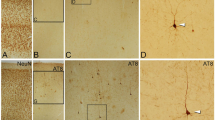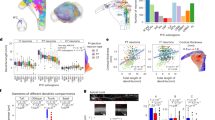Abstract
PYRAMIDAL CELLS are highly differentiated cortical neurones whose morphophysiological properties derive largely from dendritic systems that provide most of the postsynaptic sites for excitatory and inhibitory synaptic inputs1. As pyramidal cell function is closely linked to dendritic geometry2,3 factors influencing dendritic growth determine to a large extent connectivity patterns in cortical neuronal organisations4–6. Although various experimental manipulations hinder attainment of normal dendritic geometry7 no factors or conditions are known to induce dendritic growth and differentiation in intact, mature cortical neurones. I present here morphological evidence that in human ganglioside storage disease pyramidal neurones, having completed an initial period of normal dendritic growth, undergo a second phase of dendritic growth and differentiation at aberrant sites. I have referred to this in another context as ectopic dendrogenesis8.
This is a preview of subscription content, access via your institution
Access options
Subscribe to this journal
Receive 51 print issues and online access
$199.00 per year
only $3.90 per issue
Buy this article
- Purchase on Springer Link
- Instant access to full article PDF
Prices may be subject to local taxes which are calculated during checkout
Similar content being viewed by others
References
Purpura, D. P. in The Neurosciences: A Study Program (eds Quartern, G. C, Melnechuck, T. & Schmitt, F. O.) 372–393 (Rockefeller University Press, New York, 1967); and in Structure and Function of Synapses (eds Pappas, G. D. & Purpura, D. P.) 257–302 (Raven, New York, 1972).
Rall, W. in Handbook of Physiology, Section 1 Nervous System, (ed. Kandel, E. R.) 39–97 (American Physiological Society, Baltimore, Maryland, 1977).
Lux, H. D. & Pollen, D. H. J. Neurophysiol. 29, 207–220 (1966).
Scheibel, M. E. & Scheibel, A. B. Int. Rev. Neurobiol. 13, 1–26 (1970).
Sholl, D. A. Organization of the Cerebral Cortex (Wiley, New York, 1956).
Brazier, M. A. B. & Petsche, H. (eds) Architectonics of the Cerebral Cortex (Raven, New York, 1978).
Kreutzberg, G. W. (ed) Physiology and Pathology of Dendrites (Raven, New York, 1975).
Purpura, D. P. in Intrauterine Asphyxia and the Developing Fetal Brain (ed Gluck, L.) 349–372 (Year Book Medical Publishers, Chicago, 1977).
Purpura, D. P. & Suzuki, K. Brain Res. 116, 1–21 (1976).
de Baecque, C. M. et al. Acta neuropath. (Berl.) 33, 202–226 (1975).
Purpura, D. P. in Growth and Development of the Brain (ed Brazier, M. A. B.) 33–49 (Raven, New York, 1975); and in Brain Dysfunction in Infantile Convulsions (eds Brazier, M. A. B. & Coceani, F.) 223–240 (Raven, New York, 1976).
Purpura, D. P. & Baker, H. J. Nature 266, 553–554 (1977); Brain Res. 143, 13–26 (1977).
Peters, A. & Kaiserman-Abramof, I. R. Am. J. Anat. 127, 321–356 (1970).
Purpura, D. P., Pappas, G. D. & Baker, H. J. Brain Res. 143, 1–12 (1977).
Author information
Authors and Affiliations
Rights and permissions
About this article
Cite this article
PURPURA, D. Ectopic dendritic growth in mature pyramidal neurones in human ganglioside storage disease. Nature 276, 520–521 (1978). https://doi.org/10.1038/276520a0
Received:
Accepted:
Issue Date:
DOI: https://doi.org/10.1038/276520a0
This article is cited by
-
Axonal abnormalities in cerebellar Purkinje cells of the ?hyperspiny Purkinje cell? mutant mouse
Journal of Neurocytology (1990)
-
Ganglioside function in the development and repair of the nervous system
Molecular Neurobiology (1989)
-
Lectin histochemistry of gangliosidosis
Acta Neuropathologica (1988)
-
Sphingomyelin lipidosis in a cat: Golgi studies
Acta Neuropathologica (1984)
Comments
By submitting a comment you agree to abide by our Terms and Community Guidelines. If you find something abusive or that does not comply with our terms or guidelines please flag it as inappropriate.



